Use the Holder Profile tab to calculate the maximum shape of a tool holder and shank on a toolpath during toolpath calculation. After the calculation, you can check that specific holders and shanks lie inside the maximum shape, which means they are capable of machining the part, without having to go through collision checking.
To display a Tool dialog:
- Click Home tab > Tool panel > Create Tool; or
- From the Tools context menu, select Create Tool.
To calculate the holder profile, the tool assembly must:
- include a tool tip, a shank, and a holder.
- be used by a toolpath.
This tab contains the following:
Toolpath table — This displays all of the toolpaths that use the tool and shows whether the tool can machine the part without a collision. The table has four columns:

- Toolpath — This displays the toolpaths that use the tool.
-
Draw — Toggle a light bulb on
 or off
or off
 to draw or undraw the toolpaths on the model.
to draw or undraw the toolpaths on the model.
- Include — Select to include a toolpath in the holder profile calculation.
-
Status — This displays the status of the toolpath.
 — The tool assembly does not collide with the part during machining.
— The tool assembly does not collide with the part during machining.
 — The tool assembly collides with the part. The colliding component is shaded red.
— The tool assembly collides with the part. The colliding component is shaded red.
 — The toolpath profile has not been calculated.
— The toolpath profile has not been calculated.
 Include All Toolpaths — Click to include all toolpaths in the holder profile calculation.
Include All Toolpaths — Click to include all toolpaths in the holder profile calculation.
 Exclude All Toolpaths — Click to exclude all toolpaths in the holder profile calculation. This is useful if you want to reset the toolpath selection and select the toolpaths individually.
Exclude All Toolpaths — Click to exclude all toolpaths in the holder profile calculation. This is useful if you want to reset the toolpath selection and select the toolpaths individually.
 Copy Tool Profile — Click to create a copy of the tool profile and associate the toolpaths that were associated with the old tool with the new tool.
Copy Tool Profile — Click to create a copy of the tool profile and associate the toolpaths that were associated with the old tool with the new tool.
As an example:
- Initially the tool has four toolpaths associated with it:
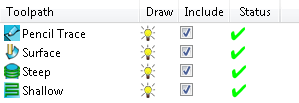
- Select two of the toolpaths:

- Click
 . This leaves two toolpaths associated with the original tool:
. This leaves two toolpaths associated with the original tool:

and two toolpaths associated with the new tool:

 because both create a copy of an existing tool. With
because both create a copy of an existing tool. With
 the toolpaths associated with the existing tool are now associated with the new tool. With
the toolpaths associated with the existing tool are now associated with the new tool. With
 all the toolpaths, except for the active toolpath, remain associated with the existing tool.
all the toolpaths, except for the active toolpath, remain associated with the existing tool.
Holder Clearance — Specify the minimum allowable distance between the model and the tool holder profile.
Shank Clearance — Specify the minimum allowable distance between the model and the tool shank profile.
The Holder Profile tab displays the Holder Profile and the Shank Profile.
- If the
Holder Clearance and the
Shank Clearance are the same, one profile is displayed:
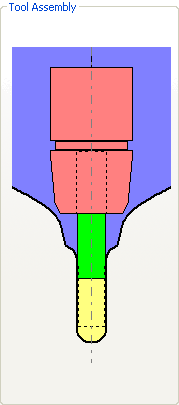
- If the
Holder Clearance is smaller than the Shank Clearance, two profiles are displayed:
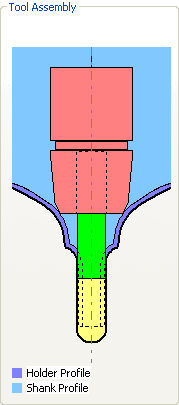
- If the
Shank Clearance is smaller than the Holder Clearance, you will see two profiles:

If you just want to see the Holder Profile select the Holder tab.

Tolerance —Specify how accurately the tool holder profile follows the model.
Maximum Profile Diameter — Specify the maximum diameter of the profile (either the holder or the shank). The value 0.0 means no maximum diameter is set.
Maximum Profile Diameter —0.0 (unlimited):
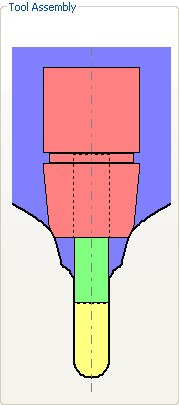
Maximum Profile Diameter — 90:
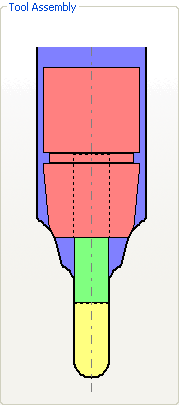
Recalculates Profiles — Click to calculate the profiles for any toolpath that has this status
 .
.
Tool Assembly — This area displays the defined parts of the tool assembly as well as the holder profile.
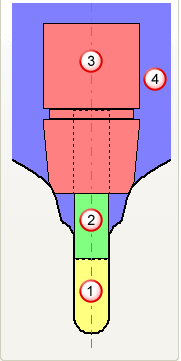
 tool
tool
 shank
shank
 holder
holder
 holder profile
holder profile
 — Select a value from the list to zoom in or out of the tool assembly. You can then use the mouse to pan the image.
— Select a value from the list to zoom in or out of the tool assembly. You can then use the mouse to pan the image.
 — Use the slide bar to zoom in or out of the tool assembly. You can then use the mouse to pan the image.
— Use the slide bar to zoom in or out of the tool assembly. You can then use the mouse to pan the image. Tool Assembly Preview — Click to display the
Tool Assembly Preview dialog. The dialog is useful for looking in detail at large tool assemblies that are too large to be seen effectively in the
Tool Assembly pane.
Tool Assembly Preview — Click to display the
Tool Assembly Preview dialog. The dialog is useful for looking in detail at large tool assemblies that are too large to be seen effectively in the
Tool Assembly pane.
 Load Tool Assembly — Click to display the
Import Tool Assembly
dialog. The dialog enables you to load a tool, shank and holder profile that has been created in
PowerShape or an alternative CAD program. A tool assembly must have the tool defined in yellow, the shank in green and the holder in pink. This button is available only on the
Form tool and the
Routing tool dialogs.
Load Tool Assembly — Click to display the
Import Tool Assembly
dialog. The dialog enables you to load a tool, shank and holder profile that has been created in
PowerShape or an alternative CAD program. A tool assembly must have the tool defined in yellow, the shank in green and the holder in pink. This button is available only on the
Form tool and the
Routing tool dialogs.
 Copy Tool — Click to create a new tool entity based on the current tool. It has the same name as the previous tool with the addition of
_1. You can then change any parameters you want without changing the original tool, but you need to bear in mind that, where the original tool is used in an active toolpath, the new tool assembly replaces the original tool assembly. Use this to create a shank and/or holder for an existing tool definition and is useful when collision checking.
Copy Tool — Click to create a new tool entity based on the current tool. It has the same name as the previous tool with the addition of
_1. You can then change any parameters you want without changing the original tool, but you need to bear in mind that, where the original tool is used in an active toolpath, the new tool assembly replaces the original tool assembly. Use this to create a shank and/or holder for an existing tool definition and is useful when collision checking.
 Clear Tool Assembly
— Click to delete all items in the tool assembly. This
Clear Tool Assembly
— Click to delete all items in the tool assembly. This
 is displayed in the Explorer to tell you that the tool is not valid.
is displayed in the Explorer to tell you that the tool is not valid.
 Add Tool to Tool Database — Click to display the
Tool Database Export dialog. Adding a tool to the
Tool Database is useful if you want to reuse the tool in the future.
Add Tool to Tool Database — Click to display the
Tool Database Export dialog. Adding a tool to the
Tool Database is useful if you want to reuse the tool in the future.